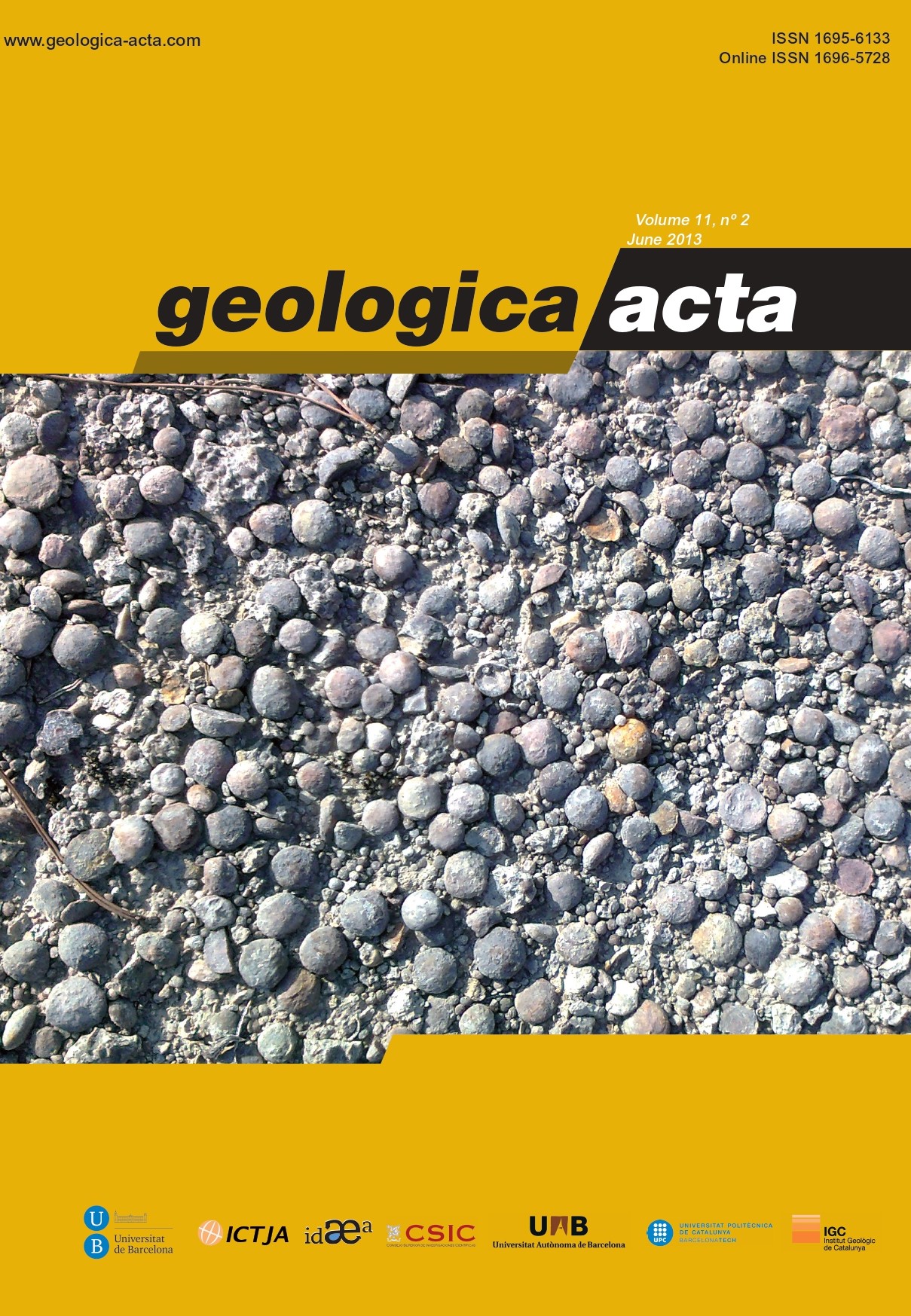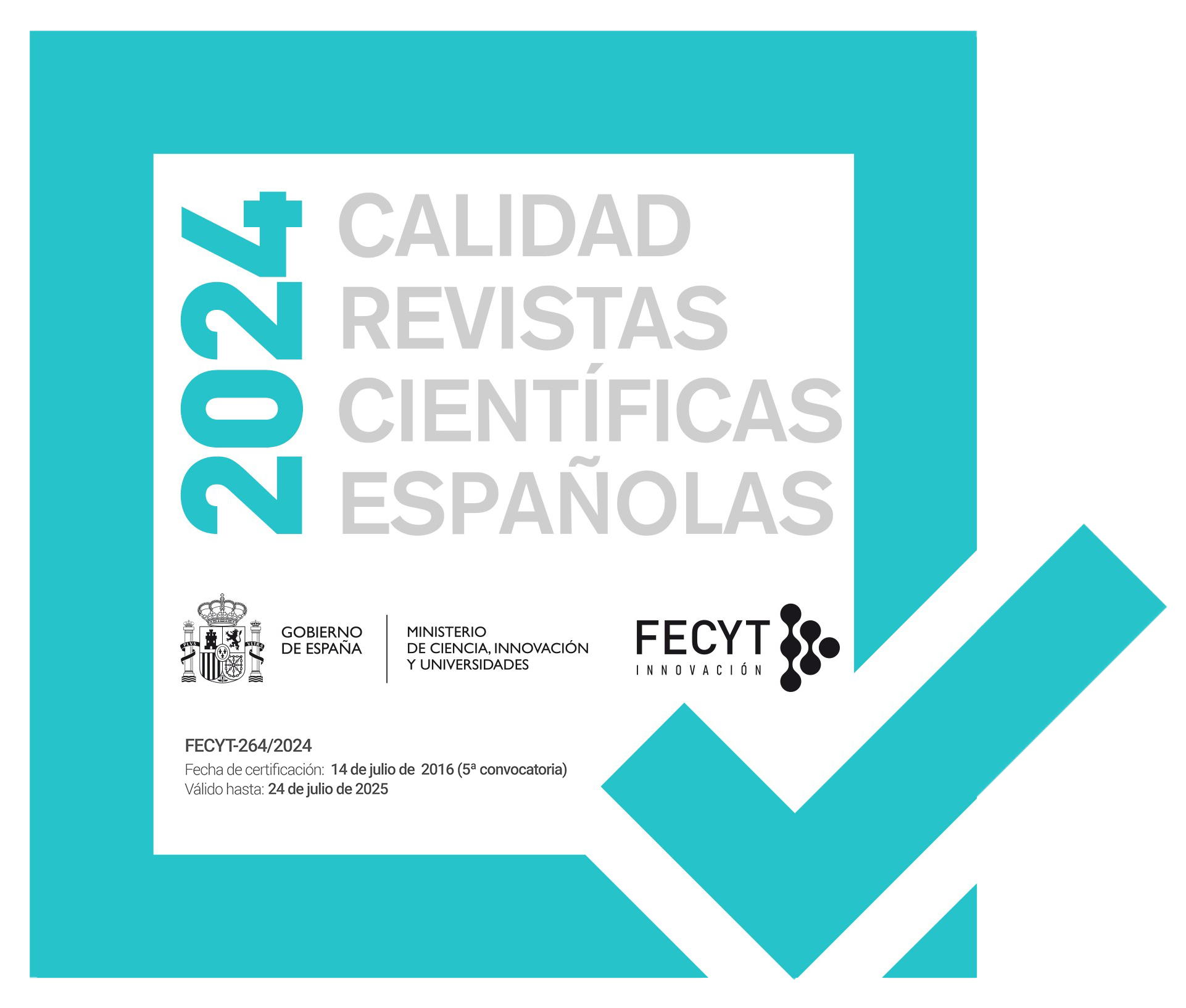Spinel group minerals in metamorphosed ultramafic rocks from Río de Las Tunas belt, Central Andes, Argentina
DOI:
https://doi.org/10.1344/105.000001836Keywords:
Spinel group minerals, Metaperidotites, Alpine type belts, Central AndesAbstract
In the Río de Las Tunas belt, Central Andes of Argentina, spinel group minerals occur in metaperidotites and in reaction zones developed at the boundary between metaperidotite bodies and their country-rocks. They comprise two types: i) Reddish-brown crystals with compositional zonation characterized by a ferritchromite core surrounded by an inner rim of Cr-magnetite and an outer rim of almost pure magnetite. ii) Green crystals chemically homogeneous with spinel (s.s.) and/or pleonaste compositions. The mineral paragenesis Fo+Srp+Cln+Tr+Fe-Chr and Fo+Cln+Tr+Tlc±Ath+Fe-Chr observed in the samples indicate lower and middle grade amphibolite facies metamorphic conditions. Nonetheless, the paragenesis (green)Spl+En+Fo±Di indicates that granulite facies conditions were also reached at a few localities. Cr-magnetite and magnetite rims in zoned reddish-brown crystals and magnetite rims around green-spinel/pleonaste grains are attributed to a later serpentinization process during retrograde metamorphism. The chemical composition of spinel group minerals in the ultramafic reaction zones is determined by the mineral zone where they crystallize. Green pleonaste occurs in the chlorite zone, ferritchromite predominates in the amphibole zone, whereas Crmagnetite and magnetite are more common in the carbonate zone. The mineral paragenesis of the Río de Las Tunas metaperidotites together with the chemical characteristics of the spinel group minerals support a clockwise P-T path evolution for the ultramafic protoliths during the Paleozoic regional metamorphic cycle of this area.
References
Astini, R., Benedetto, J., Vaccari, N., 1995. The early Paleozoic evolution of the Argentina Precordillera as a Laurentian rifted,
drifted and collided terrain: a geodynamic model. Geological Society of America, 107 (Bulletin), 253-273.
Barnes, S.J., Roeder, P.L., 2001. The range of spinel compositions in terrestrial mafic and ultramafic rocks. Journal of Petrology, 12, 2279-2302.
Bjerg, E.A., 1985. Aspectos genéticos del proceso de mineralización y su relación con los cuerpos serpentínicos del área de las minas Salamanca, La Luisa y La Barrera, departamento Tupungato, provincia de Mendoza. Doctoral thesis. Universidad Nacional del Sur, Bahía Blanca, Argentina, 93pp.
Bjerg, E.A., Gregori, D.A., Losada Calderón, A., Labadía C.H., 1990. Las metamorfitas del faldeo oriental de la Cuchilla de Guarguaráz, Cordillera Frontal, Provincia de Mendoza. Revista de la Asociación Geológica Argentina, 45, 234-245.
Bjerg, E.A., Brodtkorb, M.K. de, Stumpfl, E.F., 1993. Compositional zoning in Zn-chromites from the Cordillera Frontal Range, Argentina. Mineralogical Magazine, 57, 131-139.
Bliss, N.W., MacLean, W.H., 1975. The paragenesis of zoned chromites from central Manitoba. Geochimica et Cosmochimica Acta, 39, 973-990.
Caminos, R., 1993. El Basamento Metamórfico ProterozoicoPaleozoico Inferior. In: Ramos, V. (ed.). Geología y Recursos Naturales de Mendoza. 12º Congreso Geológico Argentino y 2º Congreso de Exploración de Hidrocarburos, Mendoza, Argentina. Relatorio 1, 11-19.
Caminos, R., Cordani, U.G., Linares, E., 1979. Geología y geocronología de las rocas metamórficas y eruptivas de la Precordillera y de la Cordillera Frontal de Mendoza, República Argentina. 2º Congreso Geológico Chileno, Arica, Chile. Actas
, F43-F60.
Candia, M.A.F., Gaspar, J.C., 1997. Chromian spinel in metamorphosed ultramafic rocks from Mangabal I and II complexes, Goiás, Brazil. Mineralogy and Petrology, 60, 27-40.
Davis, J.S., Roeske, S.M., McClelland, W.C., Snee, L.W., 1999. Closing the ocean between the Precordillera terrane and Chilenia: Early Devonian ophiolite emplacement and deformation in the southwest Precordillera. In: Ramos, V.A., Keppie J.D. (eds.). Laurentia-Gondwana connections before Pangea, Colorado, Geological Society of America, 336 (Special Paper), 115-138.
Davis, J.S., Roeske, S.M., McClelland, W.C., Kay, S.M., 2000. Mafic and ultramafic crustal fragments of the southwester Precordillera terrane and their bearing on tectonic models of the early Paleozoic in western Argentina. Geology, 28, 171-174.
Deer, W.A., Howie, R.A., Zussman, J., 1992. An introduction to the rock-forming minerals. Harlow, England, ed. Longman Scientific & Technical, 695pp.
Esawi, E.K., 2004. AMPH-CLASS: An Excel spreadsheet for the classification and nomenclature of amphiboles based on the 1997 recommendations of the International Mineralogical Association. Computers & Geosciences, 30, 753-760.
Evans, B.W., Frost, B.R., 1975. Chrome-spinel in progressive metamorphism – a preliminary analysis. Geochimica et Cosmochimica Acta, 39, 959-972.
Frost, B.R., 1991. Stability of oxide minerals in metamorphic rocks. In: Lindsley, D.H. (ed.). Reviews in Mineralogy. Oxide Minerals: Petrologic and magnetic significance. Vol. 25, Mineralogical Society of America, 469-487.
Ganuza, M.L., Castro, S.M., Martig, S., Ferracutti, G., Bjerg, E., 2009. Mineral compositions visualization implementing the spinel prism. 15º Congreso Argentino de Ciencias de la Computación. Anales, 576-585.
Gargiulo, M.F., 2010. Petrología, geoquímica y evolución metamórfica de la Faja máfica-ultramáfica del Río de Las Tunas, Mendoza, Argentina. Doctoral thesis. Universidad Nacional del Sur, Bahía Blanca, Argentina, 250pp.
Gargiulo, M.F., Bjerg, E.A., 2006. Petrografía y geoquímica de rocas máficas y ultramáficas de Cordillera Frontal, Mendoza. 8º Congreso de Mineralogía y Metalogenia, Buenos Aires, Argentina. Actas, 351-358.
Gargiulo, M.F., Bjerg, E.A., Mogessie, A., 2010. Zonalidad composicional en anfíboles de las zonas de reacción entre los cuerpos ultramáficos y la roca de caja metasedimentaria del Complejo Guarguaráz, Cordillera Frontal de Mendoza, Argentina. 10º Congreso de Mineralogía y Metalogenia, Río Cuarto, Argentina. Actas 1, 85-92.
Gargiulo, M.F., Bjerg, E.A., Mogessie, A., 2011. Caracterización y evolución metamórfica de las rocas ultramáficas de la faja del Río de Las Tunas, Cordillera Frontal del Mendoza. Revista de la Asociación Geológica Argentina, 68, 571-593.
Gregori, D.A., Bjerg, E.A., 1997. New evidence on the nature of the Frontal Cordillera Ophiolitic belt – Argentina. Journal of
South American Earth Sciences, 10, 147-155.
Gregori D.A., Ruviños, M.A., Bjerg, E.A., 1997. Las metamorfitas del basamento de la Cordillera Frontal, entre el Río de las Tunas y el Arroyo Barraquero, Provincia de Mendoza. 8º Congreso Geológico Chileno, Antofagasta, Chile. Actas, 2, 857-861.
Haggerty, S.E., 1991. Oxide mineralogy of the upper mantle. Spinel mineral group. In: Lindsley, D.H. (ed.). Reviews in Mineralogy, Oxide minerals: Petrologic and magnetic significance. Vol. 25, Mineralogical Society of America, 355-416.
Haller, M., Ramos, V.A., 1984. Las ofiolitas famatinianas (Eopaleozoico) de las provincias de San Juan y Mendoza. 9º Congreso Geológico Argentino, San Carlos de Bariloche, Argentina. Actas, 2, 66-83.
Haller, M., Ramos, V.A., 1993. Las Ofiolitas y otras rocas afines. In: Ramos, V.A. (ed.). Geología y Recursos Naturales de Mendoza. 12º Congreso Geológico Argentino y 2º Congreso de Exploración de Hidrocarburos, Mendoza, Argentina. Relatorio, 1, 31-39.
Irvine, T.N., 1967. Chromian spinels as a petrogenentic indicator. Part 2 Petrologic applications. Canadian Journal of Earth
Sciences, 4, 71-103.
Kretz, R., 1983. Symbols for rock-forming minerals. American Mineralogist, 68, 277-279.
López, V.L., 2005. Geología y Petrología de la Cuchilla de Guarguaráz, Cordillera Frontal de Mendoza. Doctoral thesis. Universidad Nacional del Sur, Bahía Blanca, Argentina, 269pp.
López, V.L., Gregori, D.A., 2004. Provenance and evolution of the Guarguaráz Complex, Cordillera Frontal, Argentina. Gondwana Research, 7, 1197-1208.
López de Azarevich, V.L., Escayola, M., Azarevich, M.B., Pimentel M.M., Tassinari, C., 2009. The Guarguaráz Complex and the Neoproterozoic-Cambrian evolution of the southwestern Gondwana: Geochemical signature and geochronological constrains. Journal of South American Earth Sciences, 28, 333-344.
Massone, H.J., Calderón, M., 2008. P-T evolution of metapelites from the Guarguaráz Complex, Argentina: evidence for Devonian crustal thickening close to the western Gondwana margin. Revista Geológica de Chile, 35, 215-231.
Mogessie, A., Ettinger, K., Leake, B.E., 2004. IMA-Amphibole Classification Scheme, London, Mineralogical Society, www.minersoc.org.
Polanski, J., 1972. Descripción Geológica de la Hoja 24 a-b “Cerro Tupungato”, Provincia de Mendoza. Carta GeológicoEconómica de la República Argentina, Escala 1:200.000. Boletín 128, Buenos Aires, Dirección Nacional de Geología y Minería de Argentina, 129pp., 1 fold. map.
Ramos, V.A., 1999. Las Provincias Geológicas del Territorio Argentino. In: Caminos, R. (ed.). Geología Argentina. Instituto de Geología y Recursos Minerales, Buenos Aires, Argentina. Anales, 29, 41-96.
Ramos, V.A., 2010. The Grenville-age basement of the Andes. Journal of South American Earth Sciences, 29, 77-91.
Ramos, V.A., Basei, M., 1997. The Basement of Chilenia: an exotic continental terrane to Gondwana during Early Paleozoic. Symposium on Terrane Dynamics´97, New Zealand. Actas, 140-143
Ramos, V., Jordan, T., Allmendinger, R., Kay, S., Cortés, J., Palma, M., 1984. Chilenia: un terreno alóctono en la evolución paleozoica de los Andes Centrales. 9º Congreso Geológico Argentino, San Carlos de Bariloche, Argentina. Actas, 2, 84-106.
Ramos, V., Jordan, T., Allmendinger, R., Mpodozis, C., Kay, S., Cortés, J., Palma, M., 1986. Paleozoic terranes of the central argentine-chilean Andes. Tectonics, 5, 855-888.
Rapalini, A.E., Astini, R.A., 1997. Paleomagnetic confirmation of the Laurentian origin of the Argentine Precordillera. Earth and Planetary Science Letters, 155, 1-14.
Ruviños, M.A., Gregori, D.A., Bjerg, E.A., 1997. Condiciones de P y T del basamento metamórfico de la Cordillera Frontal de Mendoza, Argentina. 8º Congreso Geológico Chileno, Antofagasta, Chile. Actas, 2, 1512-1516.
Stevens, R.E., 1944. Composition of some chromites of the western hemisphere. American Mineralogist, 29, 1-34.
Thomas, W.A., Astini, R.A., 2003. Ordovician accretion of the Argentine Precordillera terrane to Gondwana: a review. Journal of South American Earth Sciences, 16, 67-79.
Villar, M.L., 1975. Las fajas y otras manifestaciones ultrabásicas en la República Argentina y su significado metalogénico. 2º Congreso Iberoamericano de Geología Económica. Actas, 3, 135-155.
Villar, M.L., 1996. Distribución de tierras raras en peridotitas del Complejo Ultramáfico de Novillo Muerto Cordillera Frontal
de Mendoza. 3ª Jornadas de Mineralogía, Petrografía y Metalogénesis de Rocas Máficas y Ultramáficas, Publicación del Instituto de Recursos Minerales de la Universidad de La Plata, 5, 327-328.
Villar, M.L., 1998. Los gabros de fondo oceánico de la ofiolita de la Cordillera Frontal de Mendoza, Argentina. 10º Congreso Latinoamericano de Geología y 6º Congreso Nacional de Geología Económica, Buenos Aires, Argentina. Actas, 2, 405-410.
Villar, M.L., Donnari, E.I., 1987. Geología y metalogénesis del Complejo Máfico-Ultramáfico de Los Gateados, Departamento de Tupungato, provincia de Mendoza. 10º Congreso Geológico Argentino, Simposio de Procesos Metalogénicos, Tucumán, Argentina. Correlación Geológica, 3, 45-50.
Villar, M.L., Escayola, M., 1996. Metallogenetic aspects of ophiolites and other types of Mafic and ultramafic complexes of Argentina. In: Coyner, A.R., Fahey, P.L. (eds.). Geology and Ore Deposits of the American Cordillera: Geological Society of Nevada Symposium Proceedings, 1487-1499.
Willner, A.P., Gerdes, A., Massonne, H.J., 2008. History of crustal growth and recycling at the Pacific convergent margin of South America at latitudes 29º-36ºS revealed by U-Pb and Lu-Hf isotope study of detrital zircon from late Paleozoic accretionary systems. Chemical Geology, 253, 114-129.x
Willner, A.P., Gerdes, A., Massonne, H.J., Schmidt, A., Sudo, M., Thomson, S.N. y Vujovich, G. 2011. The geodynamics of collision of a microplate (Chilenia) in Devonian times deduced by the pressure-temperature-time evolution within part of a collisional Belt (Guarguaraz Complex, W-Argentina). Contributions to Mineralogy and Petrology 162, 303-327.
Downloads
Published
Issue
Section
License

This work is licensed under a Creative Commons Attribution-ShareAlike 4.0 International License.
Copyright
Geologica Acta is the property of the UB, GEO3BCN, IDAEA and UAB. Geologica Acta must be cited for any partial or full reproduction. Papers are distributed under the Attribution-Share Alike Creative Commons License. This license allows anyone to reproduce and disseminate the content of the journal and even make derivative works crediting authorship and provenance and distributing possible derivative works under the same or an equivalent license.
Author Rights
Authors retain the copyright on their papers and are authorized to post them on their own web pages or institutional repositories. The copyright was retained by the journal from the year 2003 until 2009. In all cases, the complete citation and a link to the Digital Object Identifier (DOI) of the article must be included.
The authors can use excerpts or reproduce illustrations of their papers in other works without prior permission from Geologica Acta provided the source of the paper including the complete citation is fully acknowledged.




